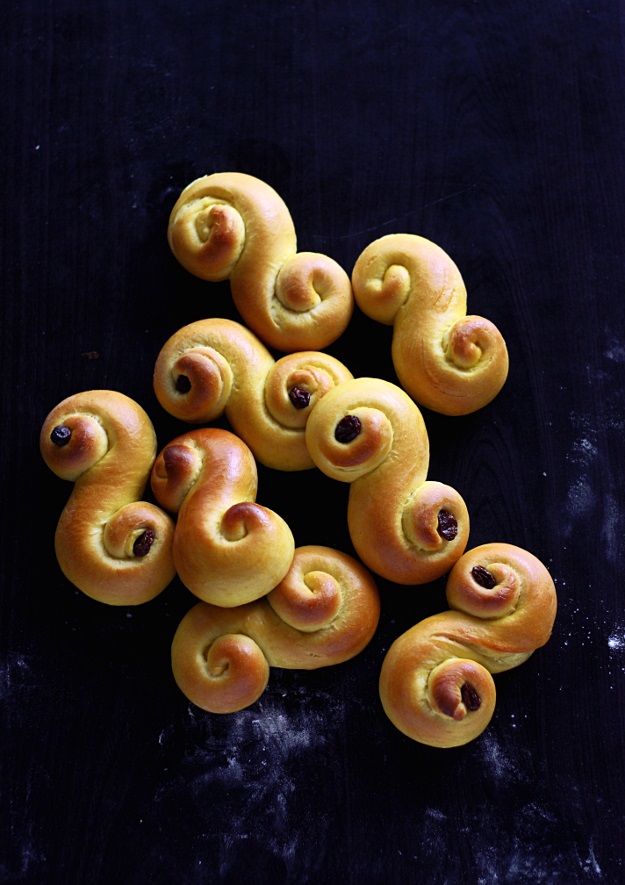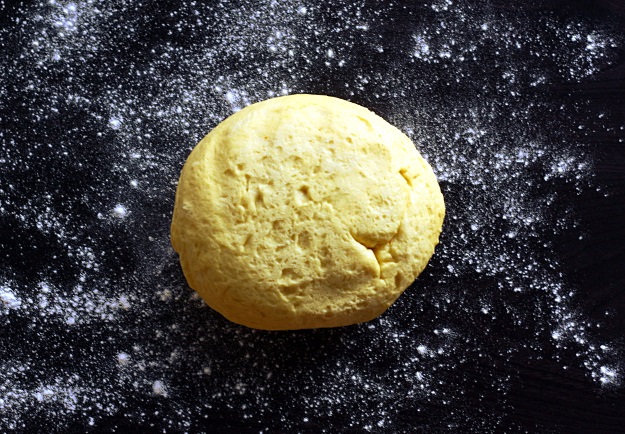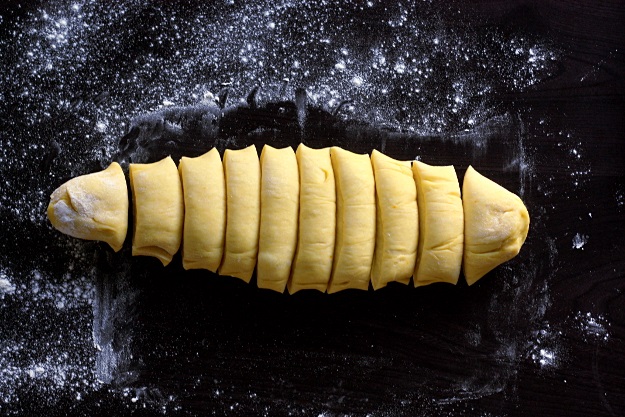 December 13th is a special day for people living in northern Europe: It is St. Lucia Day. Santa Lucia Day is most commonly celebrated in Scandinavia, especially in Sweden, with their long, dark winters. The day once coincided with the winter solstice, the shortest day of the year before calendar reforms. St. Lucia day is considered a festival of light.
December 13th is a special day for people living in northern Europe: It is St. Lucia Day. Santa Lucia Day is most commonly celebrated in Scandinavia, especially in Sweden, with their long, dark winters. The day once coincided with the winter solstice, the shortest day of the year before calendar reforms. St. Lucia day is considered a festival of light.
Sweden celebrates the day with special pastries, called Lussekatter or Lussebullar. These saffron-hued and mildly sweet buns are vibrant yellow from the saffron-infused dough and are usually served for breakfast. Some people decorate them with raisins, others with pearl sugar, which doesn’t melt during baking, and others just leave the buns plain.
How to make Lussekatter (St. Lucia Buns)

Saffron is the special ingredient in this recipe. In a mug or small ceramic bowl (plastic will discolor) mix hot milk and saffron and let it sit for 15 minutes. The milk infuses the bright color and lovely flavor.

Mix all ingredients to get a moist but not tacky dough. Let the dough rise covered at warm room temperature until doubled in bulk, about 1 to 1 ½ hours (see pic above).

Transfer the dough to a lightly floured work surface and divide the dough into 10 equal parts.

Shape each piece of dough into 14-15 inch (35-40 cm) long logs. The logs roll out smooth if the dough is relatively moist, so please don’t use too much flour. Wetting your hands or your work surface sometimes helps when the dough is too dry and doesn’t roll out easily.
Curl the ends in opposite directions, forming an “S” with spirals at both ends.

Place the shaped dough pieces 2 inch apart on parchment paper–lined baking sheets.

Let them rise in a warm place for 30 minutes or at warm room temperature for about 1 hour until the lussekatter are noticeably puffy, but not doubled. Press the raisins into the center of each spiral. I thought brushing them with saffron-milk would be a good idea an even make them brighter.
So, I did a little experiment ;-)

The two lussekatter on the left are brushed with saffron-milk, the one on the right with regular milk. The saffron-milk makes them even brighter ;-) Brushing them with milk gives them a nice golden color, but they are not glossy at all. Regular egg-wash (egg plus a little milk) or egg white mixed with a little water also makes them nice and glossy.

Bake until golden, about 10 to 15 minutes.

Remove the buns from the oven and let them cool … or wait at least 5 minutes before enjoying them.
These Lucia Saffron Buns are traditionally served for breakfast on Lucia Day, in mid-December. The saffron-hued buns are mildly sweet (I like them this way) - but you can add a little more sugar if you have a sweet tooth. Some people decorate them with raisins, others with pearl sugar, which does not melt during baking, and others just leave the buns plain.
Ingredients
- 1/3 cup + 1 tbsp (95 ml) hot milk (not boiling)
- ¼ teaspoon dry saffron (crush using mortar and pestle or in a bowl with the back of a spoon or crumble as fine as possible with your fingers)
- 1/3 cup (80 ml) warm milk
- 1 ½ teaspoons (5 g) active dry yeast*
- 3 ½ tablespoons (50 g) melted butter, cooled slightly
- 1 large egg yolk
- ¼ cup (50 g) granulated sugar
- 1/3 teaspoon fine salt
- 2 ¼ cups (320 g) all-purpose flour
- Raisins, rinsed and patted dry (optional)
* If you want to let the dough rise in the fridge overnight, half the amount of yeast.
Instructions
- In a mug or small ceramic bowl (plastic will discolor) add the hot milk and saffron and let it sit for 15 minutes. Stir occasionally. The milk infuses the bright color and lovely flavor.
- In a large bowl sprinkle the yeast over 1/3 cup warm milk and set it aside for 5 to 10 minutes for the yeast to dissolve.
- Add the melted butter, egg yolk, sugar, and salt to the yeast-milk and stir.
- Add almost all of the saffron-milk to the mixture (set 1 tablespoons aside for brushing later). If you didn’t grind your saffron, strain the slightly cooled mixture - it should be warm, not hot - through a fine mesh sieve. Stir well.
- Gradually add the flour and knead to make a workable dough. It should be on the moist side, without being tacky. If you used cups for measuring, gradually add enough of the flour (almost all of it) to make a workable dough.
- Shape into a ball, oil a bowl and let the dough rise covered at warm room temperature until doubled in bulk, about 1 to 1 ½ hours (or overnight in the fridge, see note above).
- Transfer the dough to a lightly floured work surface and divide the dough into 10 equal parts. Shape each piece of dough into 14-15 inch (35-40 cm) long logs. The logs roll out smooth if the dough is relatively moist, so please don’t use too much flour. Wetting your hands or your work surface sometimes helps when the dough is too dry and doesn’t roll out easily.
- When rolled out, lightly turn the “rope” on the floured working surface so that the dough isn’t sticking. You can skip this step, if using a tall baking dish, which you can entirely cover with cling wrap (without touching the dough). If you are using a regular baking sheet, don’t skip this step or the moist dough will stick to your tea towel later.
- Curl the ends in opposite directions, forming an "S" with spirals at both ends. Place the shaped dough pieces 2 inch apart on parchment paper–lined baking sheets.
- Cover with a tea towel (or plastic wrap when using a tall baking dish) and let rise at room temperature for 30-45 minutes until the lussekatter are noticeably puffy, but not doubled.
- Preheat the oven to 400 °F (or 200 °C).
- Uncover the dough pieces and press the raisins into the center of each spiral.
- Brush the buns with the remaining saffron-milk (or egg white mixed with 1 teasp. water or egg-wash), and bake until golden, about 8 to 12 minutes.
- Remove the buns from the oven and let them cool … or wait at least 5 minutes before enjoying them.
Did you follow this recipe? You could share your result here. All you need to do is take a picture with your smartphone and send it to [email protected]





Growing up, I had the Christmas book about Kirsten, the American Girl character. They celebrated Christmas with St. Lucia Buns and I always wanted to try them. I can’t wait to make them and finally enjoy the treat I’ve been thinking about for ages!
Haha, that sounds like something to check off your bucket list :-) I will make them again this year for sure. They are so cute.
Made this today and it was great! Receipe worked exactly as stated and it made just the right amount of soft yellow buns (nine).
Hi Ed,
Happy to hear that :-)) I always excessively test cook my recipes so I’m glad it worked in your kitchen (and oven) too ;-) Thanks so much for making them!
This recipe tastes just like the St.Lucia Buns I remember! My church was founded by Swedes and we host a St. Lucia festival every year where we also sell Swedish baked goods and gifts. For the past 3 years I have been using this recipe to make our St. Lucia buns and they’ve sold out every year. Our guests look forward to them every year many commenting on how authentic they taste. Thank you.
Hi Leigh,
You made my day!! Thank you so much for your lovely comment. Reading comments like yours are the reason why I’m still motivated and still love posting recipes here on the blog. It is so great to hear that you and the community like the buns :-))) I will make them again this year. Looking forward to baking them.
I’m Swedish and I have tried a few different recipes for lussebullar- this one is by far my favorite. They come out perfect every time! I recommend bread flour to make them extra soft and fluffy.
Hi Cilia,
So happy to hear that :))) Coming from a Swedish person even more. Yay! I hope you’ll make them again over the years. Thanks so much for your comment, you made my day!
Ursula